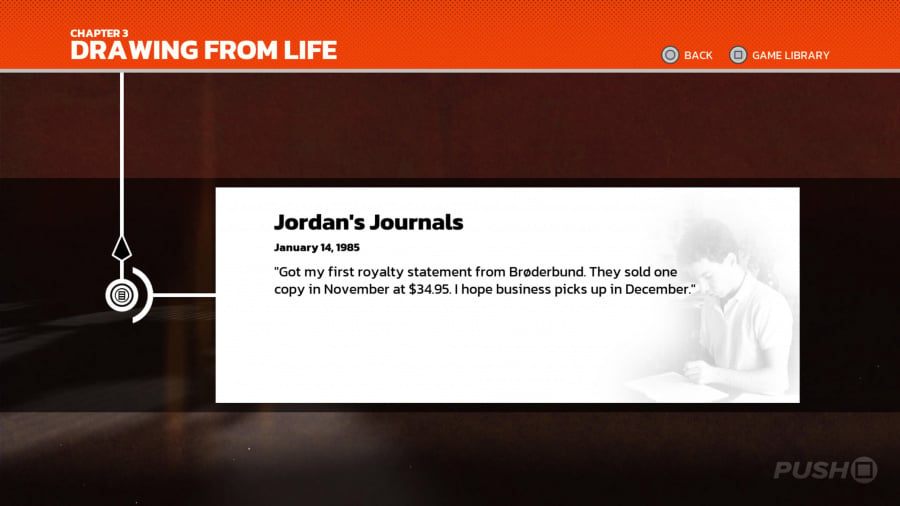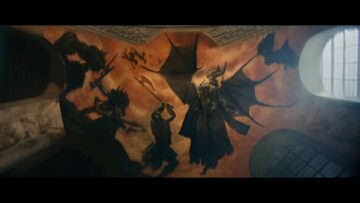The Making of Karateka is a rare treat. It’s part documentary, part archive, part collection of old games, and part remaster. It’s also a wonderful example of just how far we can go with game preservation if we put the work in, and the gold standard for how we should approach collections of classic games going forward.
For the uninitiated, Karateka was an influential game released on the Apple II way back in the olden days of 1984. It was a side-scrolling karate game, in which your unnamed protagonist must best a series of foes to save a princess, quaint by today’s standards but heralded at the time as an unparalleled cinematic gaming experience.
Karateka was the creation of Jordan Mechner — a Yale student at the time, and the man who would later go on to create Prince of Persia — and it was one of the best selling games of 1984. The Making of Karateka is an interactive documentary presented in the form of a timeline — essentially a menu — that you can peruse at your leisure, tracing Jordan’s early days dreaming of game design to his first attempt at a game, the rejection letters from publishers, the creation of Karateka, and ultimately, a new remaster of Karateka to play.
There’s scans of storyboards, planning documents, letters to publishers, fan mail, and family photographs. There’s videos with people like Gary Whitta — a former gaming journalist who later wrote the Star Wars movie, Rogue One — and John Tobias — one of the creators of Mortal Kombat — talking about their experiences with Karateka.
There’s some incredibly poignant videos showing Jordan and his father recalling the creative process they used to make the game, including a cool demonstration of how they pioneered the use of rotoscoping to give Karateka animations on a level previously unseen within the medium. Jordan’s father — also an accomplished pianist — wrote the music for Karateka, and his explanations for the use of leitmotifs necessitated by the technical limitations of the Apple II are fascinating.
And then there’s the games. Watching a video describing Jordan’s first attempt at making a video game and then actually being able to play that build — framerate dips and all — is a remarkable experience. On their own most of the games here would be little more than curios, but presented here as they are they’re a fascinating time capsule, and an enthralling window into the creative process. For anyone interested in the history of video games we can’t recommend this enough.
- SEO Powered Content & PR Distribution. Get Amplified Today.
- PlatoData.Network Vertical Generative Ai. Empower Yourself. Access Here.
- PlatoAiStream. Web3 Intelligence. Knowledge Amplified. Access Here.
- PlatoESG. Automotive / EVs, Carbon, CleanTech, Energy, Environment, Solar, Waste Management. Access Here.
- PlatoHealth. Biotech and Clinical Trials Intelligence. Access Here.
- ChartPrime. Elevate your Trading Game with ChartPrime. Access Here.
- BlockOffsets. Modernizing Environmental Offset Ownership. Access Here.
- Source: https://www.pushsquare.com/reviews/ps5/the-making-of-karateka
- 1
- 9
- a
- able
- About
- accomplished
- actually
- All
- also
- an
- and
- animations
- anyone
- Apple
- approach
- Archive
- ARE
- as
- At
- back
- BE
- being
- BEST
- build
- but
- by
- CAN
- cinematic
- Classic
- collection
- Collections
- cool
- create
- creation
- Creative
- Creators
- days
- Design
- documentary
- documents
- Early
- embed
- enough
- enthralling
- Essentially
- Example
- experience
- Experiences
- family
- fan
- far
- fascinating
- First
- For
- form
- Former
- Forward
- from
- game
- Games
- Gaming
- gaming experience
- Gary
- give
- go
- going
- Gold
- here
- his
- history
- How
- HTTPS
- if
- ii
- in
- Including
- incredibly
- influential
- interactive
- interested
- into
- Is
- IT
- john
- journalist
- jpg
- just
- later
- Level
- like
- limitations
- Little
- make
- Making
- man
- medium
- more
- most
- movie
- Music
- must
- New
- of
- Old
- on
- One
- own
- part
- People
- picture
- pioneered
- planning
- plato
- plato data intelligence
- platodata
- platogaming
- play
- poignant
- presented
- preservation
- previously
- Process
- protagonist
- ps5
- publishers
- Pushsquare
- put
- Rare
- RE
- recommend
- rejection
- released
- remarkable
- Remaster
- review
- Rogue
- s
- save
- selling
- Series
- should
- some
- standard
- standards
- Star
- Star Wars
- storyboards
- Student
- talking
- Technical
- than
- that
- The
- The Game
- their
- then
- there
- they
- this
- time
- timeline
- to
- Today
- Tracing
- treat
- ultimately
- unparalleled
- use
- used
- Video
- video games
- Videos
- was
- watching
- way
- we
- WHO
- window
- with
- within
- Work
- would
- wrote
- you
- your
- zephyrnet










